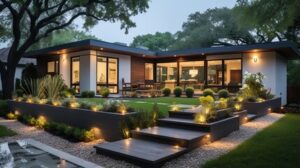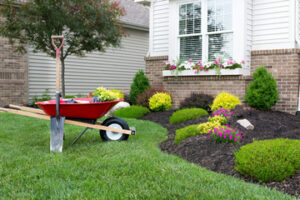Light fixtures made of frosted or tinted glass create a softer ambiance, while clear glass reflects the light better for a brighter effect. A skilled contractor can help you decide which material will best suit your aesthetic. Visit https://orlandolandscapelighting.net/ to learn more.

Turn your home and landscape into a captivating wonderland even after dark with the power of lighting. A well-lit environment makes your desired outdoor features easier to enjoy and provides safety by deterring trespassers and accidents while illuminating walkways, stairs and driveways.
Whether it’s to highlight architectural features, create an inviting ambiance, or illuminate pathways, landscape lighting provides homeowners with an array of benefits. It’s a great way to elevate the beauty of your home at night while also promoting safety and security. And with so many options available, you can find a style that matches your personality and complements the natural elements of your home’s outdoor space.
Well-lit driveways, walkways, and patios provide a safe and secure environment for family and guests. They are also a deterrent against potential intruders by illuminating potentially hazardous areas. And if you’re planning to sell your home in the future, it’s a smart investment that can increase its resale value.
Landscape lighting can also add a touch of enchantment and magic to your property. By bathing your house in a warm glow and accentuating its best features, it enhances the character of your home and sets it apart from the rest of the neighborhood. And by utilizing advanced technology, it can even serve as an effective crime deterrent by highlighting suspicious activity and helping you detect potential hazards.
If you’re considering landscape lighting for your home, it’s essential to work with a professional that has extensive experience and a good track record. They should have a portfolio of previous projects to show you, and they will be able to advise you on the different options available. They should also be able to perform a thorough site survey before starting any work, and they will usually use temporary fixtures to test their effects at various times of the day and night. This will help them identify any potential problems that need to be addressed before committing to a final installation.
Safety
A well-designed landscape lighting system can transform your outdoor space and make it safer. However, there are some safety issues that you need to keep in mind when installing your own system.
First, you should familiarize yourself with your local electrical codes and standards, or consider hiring a professional electrician for more complex installations. Next, carefully inspect your yard to ensure that it is free of potential hazards like rocks, sticks, and buried cables or wires. If you find any of these problems, have them fixed immediately.
Finally, you should make sure that the circuit for your lights is properly grounded to prevent electrical shock. This step can be tricky, but it is essential to safety. You can test your system by turning on the power and walking around to check that all of your lights are working as intended.
Once you’ve installed your lighting, it’s important to remember that the light shouldn’t be too bright or it could cause visual discomfort and limit visibility. Instead, you can use dimming to create a more ambiance-focused effect.
A good lighting design can show off a building’s best features, whether that’s brick columns, a stunning roofline, or a swank outdoor mall. It can also increase security by illuminating walkways, deterring trespassers and enhancing the look of your home or commercial space after dark. Lighting can even help you extend your business’ hours, letting customers shop and enjoy your restaurant or mall until the sun goes down. This is particularly useful for shops, restaurants, and other public spaces that need to attract more customers. Lighting can help set the mood, draw in customers, and give your business a competitive edge.
Security
Landscape lighting not only adds beauty to a property, it also enhances home security. Well-placed landscape lights create a visual deterrent to criminal activity and improve visibility, which helps deter trespassing, burglaries, and vandalism. In addition, lighting can help identify people entering a property, allowing neighbors or passersby to intervene and report suspicious activities to law enforcement.
A properly installed and maintained landscape lighting system offers many safety benefits, including the ability to enjoy outdoor spaces after dark. Using path lights, for example, enables homeowners to safely navigate their properties in the dark, and they can even illuminate walkways around their homes and driveways to prevent tripping hazards. Additionally, incorporating accent lights and spotlights into the overall lighting plan can draw attention to architectural features, trees, plants, and other landscaping elements, creating depth and drama that makes your property stand out from others.
Whether it’s for a practical or aesthetic reason, installing landscape lighting is a smart move for any homeowner. It can help make your home more attractive to potential buyers, and it can increase the overall value of your property. And best of all, it’s a great way to make your property safer for you and your family. If you’re interested in improving your home’s landscape lighting, contact Frisella Lighting today to schedule a free consultation. We will help you design an effective and aesthetically pleasing system that provides both security and safety benefits for your home. Our experienced team of professionals will guide you through the process, from the initial design phase to installation and maintenance.
Energy efficiency
Incorporating energy-efficient LED landscape lighting is a great way to light up pathways and highlight focal points, including trees and water features. Compared to traditional lighting, it uses up to 25% less energy and lasts up to 25 times longer. Using motion sensors and timers is another way to reduce energy costs while ensuring landscape lighting is activated when it is needed.
In addition to reducing energy consumption, landscape lighting also contributes to the beauty and appeal of a home or business. By highlighting walkways, entrances and architectural features of your property, lighting will create an enchanting outdoor ambiance that mesmerizes visitors and guests.
To determine what type of lighting you need, start by walking around your property at night to assess which areas are dark or could use a visual boost. This will help you plan your layout and choose the right fixtures. Once you have a basic idea of the types of lights you’d like, consider the wattage needed to properly illuminate the area. A higher wattage will result in brighter lighting, while lower wattages produce a dimmer light output.
After choosing your lighting, ensure that all wiring is well-protected and buried away from any sources of moisture, such as sprinklers or rainwater. Additionally, to prevent voltage drop, it’s a good idea to divide lights into multiple lines and use cable ties or wire nuts to neatly bundle the wire connections. These simple steps will help you avoid costly repairs and maintain your system’s optimal energy efficiency. Finally, be sure to keep up with any maintenance that may be required, such as replacing bulbs and checking for signs of wear and tear.
Maintenance
Professionally installed landscape lighting increases safety around your home, enhances the beauty of your property at night and creates a warm, welcoming mood for you and your guests. It can also add value to your home if you decide to sell in the future. But like all systems, it requires some regular maintenance to continue operating properly.
Regular inspections and cleaning will help keep your landscape lighting in optimum condition, extending its lifespan and ensuring the beauty and safety it offers. While professional assistance is often necessary for more complex tasks and system upgrades, many of these maintenance items can be performed by you or your maintenance team.
It is common for lighting fixtures to be moved or adjusted over time for a variety of reasons. These can include changes in landscaping, ground settling, foot traffic and lawn mower bumps or even simple wear and tear. This can be a quick and easy process that can improve the overall look of your lighting.
Lighting fixture lenses should be wiped down on a regular basis to remove dust, dirt, and cobwebs that can diminish the quality of the light output. Typically, a non-abrasive cloth and a CLR type of cleaner is all that is needed to restore the clarity of the lens.
As your trees and plants grow over time, they may obstruct the light path from your fixtures. Keeping up with this process can prevent your lights from being dimmed or even out of commission completely. A good way to check for this is to simply take a walk about of your property at dusk or dawn and inspect each fixture. If you notice any that aren’t working, make note of them and have them fixed as soon as possible.
